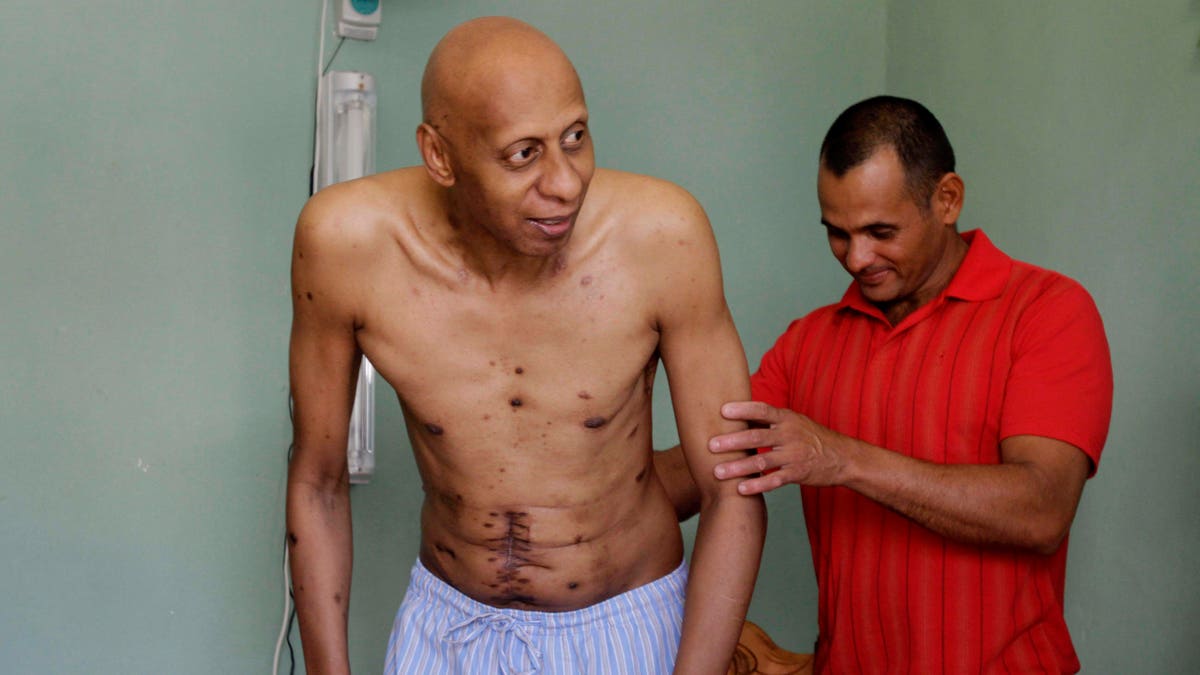
Cuban dissident Guillermo Farinas, left, is helped by medical personnel Ismel Iglesias at his home in Santa Clara, Cuba, Thursday Oct. 21, 2010. The European Parliament announced Thursday it has awarded its annual human rights prize to Farinas. The 48-year-old psychologist and freelance journalist spent three weeks in the hospital this year after a 134-day hunger strike to force the government to release opposition leaders jailed in 2003. According to Farina's spokesperson Liset Zamora, the scar on Farina's naval area is from gallbladder surgery that took place after his hunger strike and the other scars on his chest are from drainage holes related to the surgery. (AP Photo/Franklin Reyes)
Mohandas Gandhi famously started a hunger strike in 1932 to protest British rule of India. In the early 20th century, suffragettes resorted to this method as a means of political protest. And recently, a Cuban dissident awarded a European human rights prize, announced he may start a hunger strike if officials refuse to allow him to leave the island to receive the honor.
Guillermo Fariñas, 48, a psychologist and independent journalist, was awarded the prestigious Sakharov prize and more than $60,000 by the European Parliament. No stranger to protest, Fariñas has been imprisoned three times and has staged dozens of hunger strikes in protest of government actions on the communist-run island.
Fariñas’ most recent hunger strike, launched in late February, called for the release of all political prisoners in Cuba after a jailed dissident died from his own hunger strike.
During the 135-day hunger strike, Fariñas came close to death several times and spent many days in the hospital where he received nutrition through intravenous tubes.
Hunger strikes are defined as method of non-violent resistance in which the strikers fast in order to achieve a specific goal or change, according to Wikipedia and The Food Museum Online. The strikes are highly-publicized, in order to cause embarrassment to the person or group that they are targeted against, and differ from religious fasts in that they usually last for a much longer period of time.
During a hunger strike, participants typically will consume liquids, but not solid foods. This can have numerous detrimental effects on the body, including the deterioration of vital organs and even death.
In the first few days of fasting, the body still derives its energy from stored glucose. However, after three to five days, a process called ketosis begins, where the liver starts breaking down body fat.
During ketosis, toxic byproducts called ketone bodies are produced. These ketone bodies can build up in the bloodstream, causing ketoacidosis -- a potentially lethal condition that is sometimes associated with diabetes.
The danger really escalates, however, after the third week of fasting. This is when the body enters “starvation mode” and begins to mine muscles and vital organs for energy because the fat stores have been depleted. The body is, literally, consuming itself. At this point, the loss of bone marrow can become life-threatening.
Most experts agree that, without hospital intervention, a healthy adult can last on a hunger strike for about 60 days – but there’s no guarantee. In the 1970s, Irish republican Frank Stagg, died after 62 days of striking, and Cuban poet Pedro Luis Boitel, died after 53 days.
But when the striker decides to cut water from his diet as well, death comes much faster. Rasaiah Parthipan, a Sri Lankan, lasted for only nine days when he refused both food and water during his hunger strike.
Even if the strike ends before death, it can still have serious consequences for the rest of the striker’s life. Organ damage, including brain damage, can be permanent as a result of a long hunger strike. Other lasting effects include weakened bones, muscle tissue damage, and organ failure.
However, the psychology of many of these men and women is not focused on the potential health dangers of a hunger strike, but more so on their struggle for liberty, democracy and civil rights.
That focus has always superseded in bringing change. As a former Cuban dissident, I am proud of Guillermo Fariñas because he is standing for his rights, and he is also standing for the millions of Cubans that are trapped in that totalitarian regime that Fidel Castro calls a republic.
As a doctor, I can never condone the hunger strike. But as an admirer of democracy, peace and justice, I am very proud and honored to call this man a fellow Cuban.
FoxNews.com’s Alex Crees and Jessica Mulvihill contributed to this report.
Dr. Manny Alvarez is a Cuban-American OB-GYN who serves as a senior medical contributor for the Fox News Channel and senior managing health editor of FOXNews.com. To read more from Dr. Manny, click here.
